 W
WRecreational fishing, also called sport fishing, is fishing for pleasure or competition. It can be contrasted with commercial fishing, which is fishing for profit, or subsistence fishing, which is fishing for survival.
 W
WAngling is a method of fishing by means of an "angle". The hook is usually attached to a fishing line and the line is often attached to a fishing rod. Modern fishing rods are usually fitted with a fishing reel that functions as a mechanism for storing, retrieving and paying out the line. Tenkara fishing and cane pole fishing are two techniques that do not use a reel. The hook itself can be dressed with bait, but sometimes a lure, with hooks attached to it, is used in place of a hook and bait. A bite indicator such as a float, and a weight or sinker are sometimes used.
 W
WThis is an impartial and comprehensive record list of 292 British record freshwater fish, past and present, involving 57 different species/sub-species of fish caught using the traditional angling method of rod and line. Records to include the angler, species, weight, date, venue, also referenced with a recognizable publication. The list is intended to include all categories of fish caught by anglers, that enter freshwater including and some migratory sea fish. The time since last record fish was caught is 219 days.
 W
WThis list is of the heaviest European freshwater fish caught using the traditional angling method of rod and line.
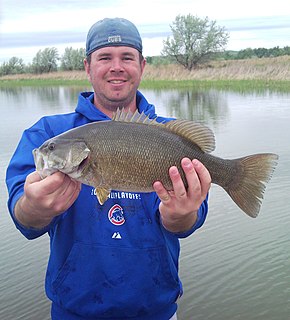 W
WBass fishing is the activity of angling for the North American gamefish known colloquially as the black bass. There are numerous black bass species considered as gamefish in North America, including largemouth bass, smallmouth bass, spotted bass or Kentucky bass, and Guadalupe bass. Black bass are members of the sunfish family, Centrarchidae.
 W
WBig-game fishing, also known as offshore sportfishing, offshore gamefishing, or blue-water fishing is a form of recreational fishing, targeting large fish such as tuna and marlin.
 W
WBowfishing is a method of fishing that uses specialized archery equipment to shoot and retrieve fish. Fish are shot with a barbed arrow that is attached with special line to a reel mounted on the bow. Some freshwater species commonly hunted include common carp, grass carp, bighead carp, alligator gar, and bowfin. In saltwater, rays and sharks are regularly pursued.
 W
WCatch and release is a practice within recreational fishing intended as a technique of conservation. After capture, the fish are unhooked and returned to the water. Often, a fast measurement and weighing of the fish, followed by photography of the catch is worthwhile. Using barbless hooks, it is often possible to release the fish without removing it from the water.
 W
WThe Chautla Hacienda was a formerly vast extension of farmland located in the San Martin Texmelucan Valley in the state of Puebla, northwest of the city of Puebla in Mexico. It was established in the 18th century, primarily producing grain. In the 19th century, it became the property of an Englishman by the name of Thomas Gillow. He passed the property to his son Eulogio Gillow, who became the first archbishop of Antequera. Eulogio worked to modernize the hacienda, building the first hydroelectric dam in Latin America on the property. He also built the property's signature building, an English style residence, locally called "El Castillo" which overlooks the dam. Today, only a small fraction of the hacienda remains, and it is run as a recreational and cultural center by an agency of the state of Puebla.
 W
WClam digging is a North American term for a common way to harvest clams from below the surface of the tidal sand flats or mud flats where they live. It is done both recreationally and commercially. Commercial digging in the U.S. and Canada is colloquially referred to as clamming, and is done by a clammer.
 W
WIn the United Kingdom and Ireland, coarse fishing refers to angling for freshwater fish which are traditionally considered undesirable as a food or game fish. Freshwater game fish are all salmonids—most particularly salmon, trout and char—so generally coarse fish, also known as rough fish, are freshwater fish that are not salmonids. There is disagreement over whether grayling should be classified as a game fish or a coarse fish.
 W
WCuttyhunk Island is the outermost of the Elizabeth Islands in Massachusetts. A small outpost for the harvesting of sassafras was occupied for a few weeks in 1602, arguably making it the first English settlement in New England. Cuttyhunk is located between Buzzards Bay to the north and Vineyard Sound to the south. Penikese Island and Nashawena Island are located to the north and east respectively.
 W
WA fishing float is an item of angling equipment. Usually attached to a fishing line, it can serve several purposes. Firstly, it can suspend the bait at a predetermined depth; secondly, due to its buoyancy, it can carry the baited hook to otherwise inaccessible areas of water by allowing the float to drift in the prevailing current; and thirdly, a float also serves as a visual bite indicator. Fishing with a float is sometimes called float fishing.
 W
WIn fishing, a gaff is a pole with a sharp hook on the end that is used to stab a large fish and then lift the fish into the boat or onto shore. Ideally, the hook is placed under the backbone. Gaffs are used when the weight of the fish exceeds the breaking point of the fishing line or the fishing pole. A gaff cannot be used if it is intended to release the fish unharmed after capture, unless the fish is skilfully gaffed in the lip, jaw, or lower gill using a thin gaff hook.
 W
WA fishing lure is a type of artificial fishing bait which is designed to attract a fish's attention. The lure uses movement, vibration, flash and color to bait fish. Many lures are equipped with one or more hooks that are used to catch fish when they strike the lure. Some lures are placed to attract fish so a spear can be impaled into the fish or so the fish can be captured by hand. Most lures are attached to the end of a fishing line and have various styles of hooks attached to the body and are designed to elicit a strike resulting in a hookset. Many lures are commercially made but some are hand made such as fishing flies. Hand tying fly lures to match the hatch is considered a challenge by many amateur entomologists.
 W
WFishingBooker is the largest online marketplace for booking yacht charters for recreational fishing. The site has been described as “Airbnb for fishing charters”.
 W
WFly fishing is an angling method that uses a light-weight lure—called an artificial fly—to catch fish. The fly is cast using a fly rod, reel, and specialized weighted line. The light weight requires casting techniques significantly different from other forms of casting. The flies may resemble natural invertebrates, baitfish, or other food organisms.
 W
WFly Tyer is an American magazine dedicated to the subject of fly tying, the art of tying materials to a hook for the purposes of fly fishing. Published four times a year, Fly Tyer is currently the largest fly-tying magazine in terms of circulation. It employs "perfect binding" instead of stapled pages, and usually features a close-up image of a fly on its cover.
 W
WGame fish or quarry are fish pursued by recreational anglers. They can be freshwater or saltwater fish. Game fish can be eaten after being caught. Some game fish are also targeted commercially, particularly salmon.
 W
WGray's Sporting Journal is a magazine dedicated to the pursuit of outdoor recreation, with an emphasis on hunting and fishing. It is a consciously literary publication, using a "blind reader" to select articles, poems, and stories for publication. The blind reader receives only the text of the submitted work, not the name of the author, thus theoretically preventing publication of works based on fame only.
 W
WHollowell is a village and civil parish in the Daventry district of the county of Northamptonshire in England. At the time of the 2001 census, the parish's population, including the nearby hamlet of Teeton, was 353 people, increasing to 385 at the 2011 Census. The village was originally a hamlet of Guilsborough, becoming a separate parish from 1850. Hollowell is mentioned in the Domesday Survey of 1086 as belonging the Bishop of Lincoln having "... 4 villeins with 1 bordar having 1 plough. It was, and is worth, 10 schillings. Bardi held (it) freely."
 W
WKayak fishing is fishing from a kayak. The kayak has long been a means of transportation and a means of accessing fishing grounds. Kayak fishing has gained popularity in recent times.
 W
WLobsters are widely fished around the world for their meat. They are often hard to catch in large numbers, but their large size can make them a profitable catch. Although the majority of the targeted species are tropical, the majority of the global catch is in temperate waters.
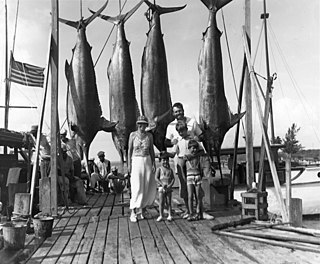 W
WMarlin fishing is considered by some game fishermen to be a pinnacle of offshore game fishing, due to the size and power of the four marlin species and their relative rareness. Fishing for marlin captured the imagination of some sport fishermen in the 1930s, when well-known angler/authors Zane Grey, who fished for black, striped, and blue marlin in the Pacific, and Ernest Hemingway, who fished the Florida Keys, Bahamas and Cuba for Atlantic blue marlin and white marlin, wrote extensively about their pursuit and enthused about the sporting qualities of their quarry.
 W
WNoodling is fishing for catfish using one's bare hands, and is practiced primarily in the southern United States. The noodler places their hand inside a discovered catfish hole. Many other names are used in different regions for the same activity.
 W
WA panfish, also spelled pan-fish or pan fish, is an edible game fish that usually does not outgrow the size of a frying pan. The term is also commonly used by anglers to refer to any small catch that will fit in a pan but is large enough to be legal. The species which match this definition and usage vary according to geography. According to the Oxford English Dictionary, the term was first recorded in 1796 in American Cookery, the first known cookbook written by an American.
 W
WPeacock bass (Cichla) is a genus of large cichlids, diurnal and predatory freshwater fish native to the Amazon and Orinoco basins, as well as rivers of the Guianas, in tropical South America. They are sometimes referred to in English by their Brazilian name tucunaré or their Spanish name pavon. Despite the common name and their superficial similarity, they are not closely related to other fish known as bass, such as the North American largemouth bass.
 W
WErnest Hemingway owned a 38-foot (12 m) fishing boat named Pilar. It was acquired in April 1934 from Wheeler Shipbuilding in Brooklyn, New York, for $7,495. "Pilar" was a nickname for Hemingway's second wife, Pauline, and also the name of the woman leader of the partisan band in his 1940 novel of the Spanish Civil War, For Whom the Bell Tolls. Hemingway regularly fished off the boat in the waters of Key West, Florida, Marquesas Keys, and the Gulf Stream off the Cuban coast. He made three trips with the boat to the Bimini islands wherein his fishing, drinking, and fighting exploits drew much attention and remain part of the history of the islands. In addition to fishing trips on Pilar, Hemingway contributed to scientific research which included collaboration with the Smithsonian Institution. Several of Hemingway's books were influenced by time spent on the boat, most notably, The Old Man and the Sea (1953) and Islands in the Stream (1970). The yacht also inspired the name of Playa Pilar on Cayo Guillermo. A smaller replica of the boat is depicted in the opening and other scenes in the 2012 film Hemingway & Gellhorn.
 W
WThe Piscatorial Society is one of the oldest angling societies in England, if not the world. It was founded in 1836 and still flourishes today. It leases fly fishing water on a number of chalk streams in Hampshire and Wiltshire, including the Wylye, the Test, the Itchen and the Hampshire Avon. It no longer has a base in London, but maintains a Rod Room on one of its Wiltshire rivers. Although members originally fished for all sorts of fish, the society now concentrates on fishing for brown trout and grayling with upstream dry fly or unweighted nymph imitations dressed lightly in the style of G. E. M. Skues.
 W
WPorgy is the common name in the US for any fish which belongs to the family Sparidae. They are also called bream. Porgies live in shallow temperate marine waters and are bottom-dwelling carnivores. Most species possess grinding, molar-like teeth. They are often good eating fish, particularly the gilt-head bream and the dentex.
 W
WRock fishing is fishing from rocky outcrops into the sea. It is a popular pastime in Australia and New Zealand. It can be a dangerous pastime and claims many lives each year, although this may improve as more fishermen are beginning to wear life jackets.
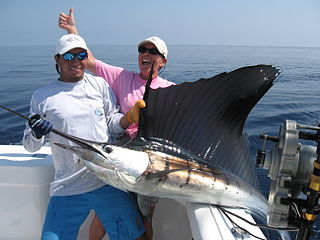 W
WSalt Water Sportsman is a monthly magazine about recreational marine fishing in the United States and throughout the world. Originally published in Boston, Massachusetts in 1939, Salt Water Sportsman expanded from its roots covering New England waters to address saltwater fishing issues throughout the world. The magazine is based in Winter Park, Florida.
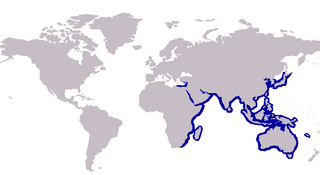 W
WSmelt-whiting is the common name for various species of the family Sillaginidae. The Sillaginidae are distributed throughout the Indo-Pacific region, ranging from the west coast of Africa to Japan and Taiwan in the east, as well occupying as a number of small islands including New Caledonia in the Pacific Ocean. Well known members of this family include King George whiting, Japanese whiting, northern whiting, sand whiting and school whiting.
 W
WSnagging, also known as snag fishing, snatching, snatch fishing, jagging (Australia), or foul hooking, is a method of fishing that entails catching a fish using hooks without the fish having to take the bait with its mouth. This is achieved by pulling the fishing line out of the water very quickly as soon as any movement is felt on the line, with the intention of piercing the fish in the flesh with the hook. Weighted lures with multiple hooks are often used to increase chances of success.
 W
WSpearfishing is a method of fishing that has been used throughout the world for millennia. Early civilizations were familiar with the custom of spearing fish from rivers and streams using sharpened sticks.
 W
WThe Sportsmen's Lodge is a hotel located on Ventura Boulevard in Studio City, Los Angeles, California. Operating under various names since the 1880s, the Sportsmen's Lodge is a San Fernando Valley landmark and remains a popular spot for celebrations, dinners and public events. Located in the heart of the Valley's studio district, the Sportsmen's Lodge was a popular gathering spot for cast and crew in old Hollywood, including Clark Gable, Bette Davis, John Wayne, Humphrey Bogart, Lauren Bacall, Spencer Tracy and Katharine Hepburn.
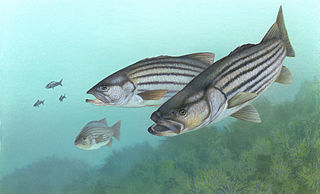 W
WStriped bass are perciform fish found all along the Atlantic coast, from Florida to Nova Scotia, and are caught as far north as Maine. They are of significant value as sporting fish, and have been introduced to many areas outside their native range.
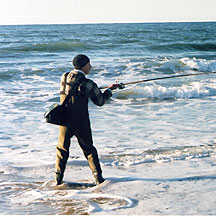 W
WSurf fishing is the sport of catching fish standing on the shoreline or wading in the surf. A general term, surf fishing may or may not include casting a lure or bait, and refers to all types of shore fishing – from sandy and rocky beaches, rock jetties, or even fishing piers. The terms surfcasting or beachcasting refer more specifically to surf fishing from the beach by casting into the surf at or near the shoreline. With few exceptions, surf fishing is done in saltwater. The most common misconception about surf fishing is the idea that one must cast as far out as possible in order to reach the fish. At beaches on the west coast of the United States, and in fact, at most beaches around the world, you only really need to get your bait into knee deep water. This is referred to as surf fishing the "skinny".
 W
WA surface lure is a fishing lure designed to waddle, pop, lock, drop, pulse, twitch or fizz across the surface of the water as it is retrieved, and in doing so imitate surface prey for fish such as mice, lizards, frogs, cicadas, moths and small injured fish. A typical surface lure has a solid body made out of wood or plastic, carries one or two treble hooks, and has an eyelet at the front of the lure body to attach the fishing line. Waddlers get their action from a scooped metal dish attached to the front of the lure body. Poppers get their action from a cupped face carved or molded into the front of the lure body. Fizzers get their action both from the fisherman manipulating the lure with the fishing rod and from one or more blades attached to the lure body, that spin when the lure is pulled and create a fizzing noise said to imitate the buzzing wings of a drowning insect.
 W
WThe tench or doctor fish is a fresh- and brackish-water fish of the order Cypriniformes found throughout Eurasia from Western Europe including the British Isles east into Asia as far as the Ob and Yenisei Rivers. It is also found in Lake Baikal. It normally inhabits slow-moving freshwater habitats, particularly lakes and lowland rivers.
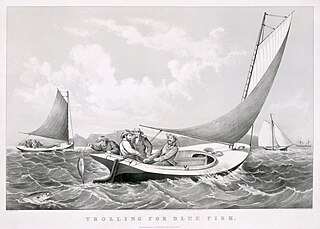 W
WTrolling is a method of fishing where one or more fishing lines, baited with lures or bait fish, are drawn through the water. This may be behind a moving boat, or by slowly winding the line in when fishing from a static position, or even sweeping the line from side-to-side, e.g. when fishing from a jetty. Trolling is used to catch pelagic fish such as salmon, mackerel and kingfish.
 W
WTrout bum is an affectionate nickname for dedicated trout anglers, particularly those who practice fly fishing. Use of the term is similar in tone and meaning to the antiquated term, "Surf bum". The term was popularized by author John Gierach, whose early work, Trout Bum is an anthology of informal, narrative essays on flyfishing; and magazine articles he wrote before 1986.
 W
WJakub Vágner is a musician, television presenter and extreme angler specializing in travel and natural history. He is best known for his television series Fish Warrior, shown on National Geographic Channel. He holds a special interest in freshwater, and has been travelling around the world fishing for giant freshwater fish.
 W
WJeremy John Wade is a British television presenter, an author of books on angling, and a biologist. He is known for his television series River Monsters, Jungle Hooks, Mighty Rivers and Dark Waters.
 W
WFishing for walleye is a popular sport with anglers. The current IGFA all tackle record is 11.34 kilograms, caught on August 2, 1960 in Old Hickory Lake, Tennessee.
 W
WThe World Fly Fishing Championship is organised by the Confédération Internationale de la Pêche Sportive and takes place annually since 1981 between 30 teams of six individuals per country, over five sessions. The 2020 FIPS Mouche World Fly Fishing Championships was postponed due to the COVID-19 pandemic and is due to be held August 10 to 17, 2021 in the Kuusamo and Taivalkoski regions of Finland.